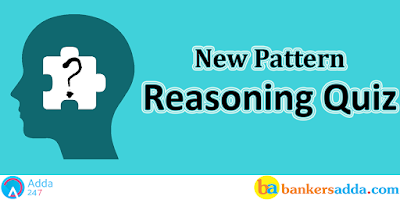Directions (1-5): नीचे दी गई जानकारी को ध्यानपूर्वक पढ़िए और नीचे दिए गये प्रश्नों के उत्तर दीजिये:
एक निश्चित कूट भाषा में
“like swacch mission india” को ” S@9 Y@23 S#9 X#14 ” लिखा जाता है
“which claims lives every” को ” S#8 S@12 F#9 W#22 ” लिखा जाता है
“people makes extreme step” को ” L@5 Q#1 W#24 H@20 ” लिखा जाता है
Q1.दी गई कूट भाषा में ‘maintained’ का कूट क्या है?
(a) N#1
(b) N@2
(c) M@1
(d) N@1
(e)इनमें से कोई नहीं
Q2. दी गई कूट भाषा में ‘dozen’ का कूट क्या है?
(a) B#5
(b) B@15
(c) A#15
(d) B#15
(e)इनमें से कोई नहीं
Q3.दी गई कूट भाषा में ‘hospital’ का कूट क्या है?
(a) H@15
(b) I@15
(c) H@1
(d) H#15
(e)इनमें से कोई नहीं
Q4. दी गई कूट भाषा में ‘girls’ का कूट क्या है?
(a) J#9
(b) J#8
(c) J@9
(d) K#9
(e) इनमें से कोई नहीं
Q5. दी गई कूट भाषा में ‘minister’ का कूट क्या है?
(a) H@10
(b) H#9
(c) K@9
(d) H@9
(e)इनमें से कोई नहीं
Directions (6-10): नीचे दिए गए प्रत्येक प्रश्न में, अंको का एक समूह दिया गया है, जिसके साथ (a), (b), (c) और (d) चार अक्षर/प्रतीक दिए गए है. आपको यह ज्ञात करना है कि चार संयोजनों में से कौन सा संयोजन अक्षर/प्रतीक कोड और नीचे दी गई शर्तों के आधार पर अंकों का समूह दर्शाता है. यदि चार संयोजनों में से कोई भी अंक के समूह को नहीं दर्शाता है, तो उत्तर (e) अर्थात् ‘इनमें से कोई नहीं’ दीजिये.
शर्त
(i) यदि पहला वर्ण कांसोनैंट है और अंतिम वर्ण वोवेल है तो इनके कूट आपस में बदल जायेंगे.
(ii) यदि दोनों पहला और अंतिम वर्ण एक कांसोनैट है, तो उनके कूट को अंतिम वर्ण के रूप में कूटित किया जाएगा.
(iii) यदि पहला वर्ण वोवेल है और अंतिम वर्ण कांसोनैंट है तो दोनों को ‘S’ के कूट के रूप में कूटित किया जाएगा.
Note: शेष वर्णों को वास्तविक कूट के अनुसार कूटित किया जाएगा.
Q6. XRWHKA
(a) 2@©6#1
(b) 1@©6#2
(c) 1@©6#1
(d) 2@©6#2
(e) इनमें से कोई नहीं
Q7. MQXKDU
(a) $42#5δ
(b) $42#5$
(c) δ42#5δ
(d) δ42#5$
(e) इनमें से कोई नहीं
Q8. TMXIUN
(a) 7$2%δ9
(b) 7$2%δ7
(c) 9$2%δ7
(d) 9$2%δ9
(e) इनमें से कोई नहीं
Q9. LTAXRI
(a) %712@3
(b) 3712@3
(c) S712@S
(d) %712@%
(e) इनमें से कोई नहीं
Q10. UKTMIH
(a) δ#7$%6
(b) 6#7$%δ
(c) S#7$%S
(d) δ7#$%6
(e) इनमें से कोई नहीं
Directions (11-12): नीचे दी गई जानकारी का अध्यन कीजिये और नीचे दिए गए प्रश्नों के उत्तर दीजिये.
P, Q, R, S, T और U छ: मित्रों का वेतन विभिन्न है. R, T से अधिक लेकिन U से कम कमाता है. Q केवल P से कम कमाता है. T सबसे कम नहीं कमाता है. T, 50000 कमाता है. वह जो तीसरा सबसे अधिक कमाता है वह 63000 कमाता है.
Q11. निम्नलिखित में से कौन सा संभवत: 49000 कमाता होगा?
(a) S
(b) Q
(c) P
(d) R
(e) U
Q12. निम्नलिखित में से कौन सी संभवत: R की आय हो सकती है?
(a) 65000
(b) 48000
(c) 70000
(d) 61000
(e) 45000
Directions (13-14): निम्नलिखित जानकारी का अध्यन कीजिये और दिए गए प्रश्नों के उत्तर दीजिये:
बिंदु F, बिंदु E के 8मी दक्षिण में है. बिंदु G, बिंदु F के 2मी पूर्व में है. बिंदु H, बिंदु G के 4मी दक्षिण में है. बिंदु I, बिंदु H के 5मी पश्चिम में है. बिंदु J बिंदु I के 8मी उत्तर में है. बिंदु K, बिंदु J के 5मी पूर्व में है. बिंदु L, बिंदु K के 4मी उत्तर में है.
Q13. F और I के मध्य सबसे कम दूरी क्या है?
(a) 5मी
(b) 3मी
(c) 4मी
(d) 2मी
(e) 1मी
Q14. यदि कोई बिंदु X, I और H के मध्य कही पर है, तो बिंदु E से X किस दिशा में है?
(a) दक्षिण-पूर्व
(b) उत्तर-पश्चिम
(c) दक्षिण-पश्चिम
(d) दक्षिण
(e) इनमें से कोई नहीं
Q15. निम्नलिखित में से कौन सा रिक्त स्थान में भरा जाना चाहिए (इसी क्रम में बाएं से दायें) ताकि इस समीकरण को इस प्रकार पूरा किया जा सके जिससे B≥D निश्चित रूप से सत्य प्रदर्शित होता हो?
B _ L _ O _ N _ D
(a) =, =, ≥, >
(b) >, ≥, =, >
(c) >, =, ≥, =
(d) ≥, =, =, ≥
(e) इनमें से कोई नहीं













